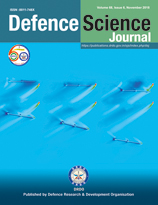Numerical Investigations on Wedge Control of Separation of a Missile from an Aircraft
DOI:
https://doi.org/10.14429/dsj.68.12552Keywords:
Missile separation, Flow control, Wedge device, Internal weapons bay, Six-degrees-of-freedomAbstract
To make the missile safely separate from the internal weapons bay, a wedge flow control device is mounted on the front of the bay to control the variation of flow during the separation. The numerical simulations of missile separation without and with wedge flow control device under different sizes are carried out. The flow fields of different separation processes are obtained and discussed; the aerodynamic parameters and trajectory parameters of missile of different cases are illustrated and compared. Results show that, the wedge flow control device can accelerate the missile separation and has the effect of regulating the angular motion of missile. The influence of the wedge height is stronger than that of its length on the center of gravity motion and angular motion of missile.Downloads
Published
2018-10-31
How to Cite
Zhu, S., Huang, Z., Gou, Y., Tang, Q., & Chen, Z. (2018). Numerical Investigations on Wedge Control of Separation of a Missile from an Aircraft. Defence Science Journal, 68(6), 583–588. https://doi.org/10.14429/dsj.68.12552
Issue
Section
Missile Systems
License
 Where otherwise noted, the Articles on this site are licensed under Creative Commons License: CC Attribution-Noncommercial-No Derivative Works 2.5 India
Where otherwise noted, the Articles on this site are licensed under Creative Commons License: CC Attribution-Noncommercial-No Derivative Works 2.5 India


